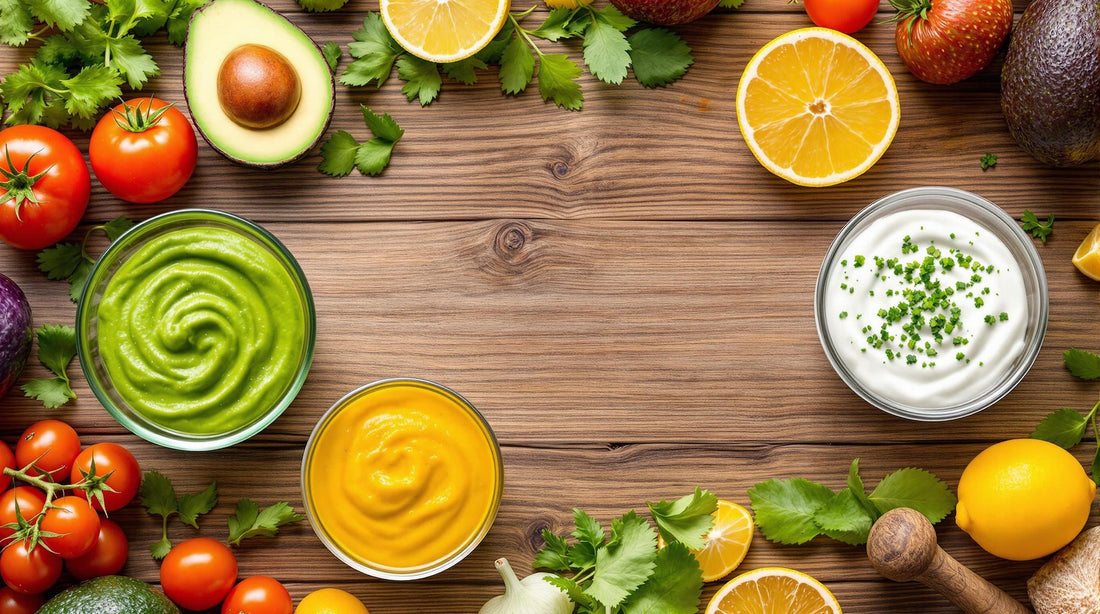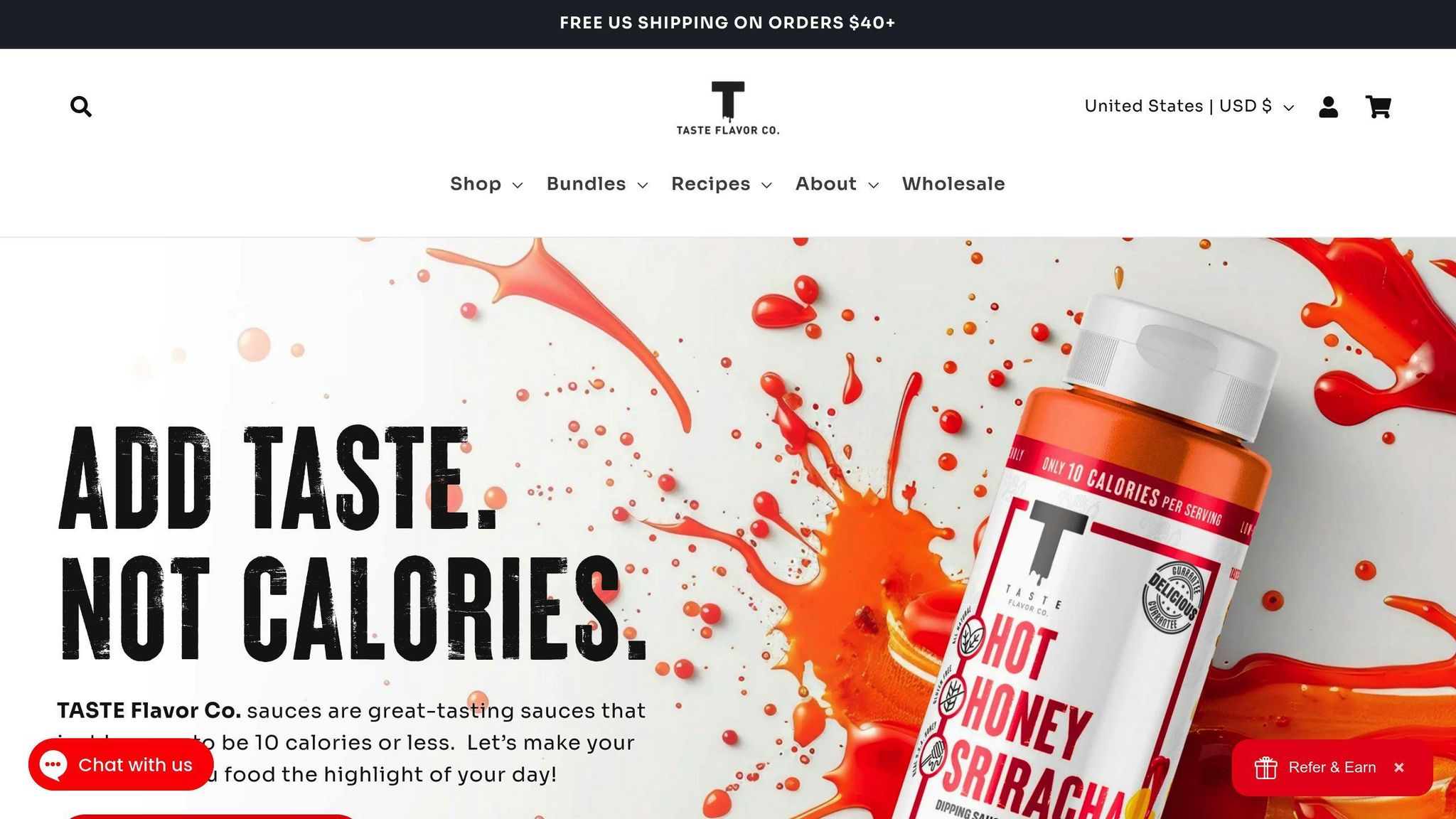
How to Choose Healthy Sauces: A Guide for Clean Eating
Share
Sauces can make your meals tastier and more nutritious - if you choose the right ones. Clean eating focuses on natural, minimally processed ingredients, and sauces should follow the same rules. Here’s how to pick or make sauces that fit your health goals:
Key Tips:
- What to Look For: Short ingredient lists with items like fresh herbs, olive oil, and natural spices.
- What to Avoid: High-fructose corn syrup, artificial preservatives, added sugars, and excessive sodium.
- Label Check: Aim for sauces with less than 5g of sugar and under 200mg of sodium per serving.
- Best Store-Bought Options: Look for brands that offer clean-label sauces.
- DIY Ideas: Simple recipes like tahini sauce, avocado dressing, or balsamic glaze let you control ingredients.
Quick Comparison Table
| Sauce Type | What to Look For | Calories (per 2 Tbsp) |
|---|---|---|
| Tomato-based | No added sugar, whole foods | 30-45 |
| Tahini | Pure sesame seeds only | 120-140 |
| Pesto | Natural oils, fresh herbs | 90-110 |
| Salsa | Fresh vegetables, no additives | 10 |
Start by reading labels carefully, or try making your own sauces at home for full control over flavor and nutrition.
What to Know About Clean Eating and Sauces
Clean eating with sauces is all about making thoughtful choices to boost both taste and nutrition. It’s important to know which ingredients align with your health goals and which ones to steer clear of.
Ingredients That Work for Clean Eating
The foundation of clean sauces lies in using whole, minimally processed ingredients. These not only add flavor but also support a healthier lifestyle.
Ingredients to Include:
- Fresh herbs like basil, mint, and cilantro
- Whole vegetables such as tomatoes, garlic, and onions
- Natural oils like extra virgin olive oil or avocado oil
- Vinegars, such as balsamic
- Citrus juices
- Pure spices and seasonings
Tahini, made from ground sesame seeds, is a great addition for protein and a creamy texture.
| Ingredient | Nutritional Perks | Common Use |
|---|---|---|
| Fresh Basil | Packed with antioxidants | Perfect for pesto |
| Olive Oil | Rich in healthy fats | Ideal for dressings |
| Tomatoes | Loaded with lycopene and vitamin C | Great for marinara |
| Tahini | High in protein and healthy fats | Adds creaminess to sauces |
Ingredients to Avoid in Sauces
When buying sauces, it’s crucial to check the label for ingredients that don’t fit clean eating principles.
Ingredients to Skip:
- High fructose corn syrup
- Artificial preservatives like BHA and Propyl Gallate
- Excessive sodium
- Artificial colors or flavors
- Unhealthy oils such as soybean or canola
- Fat-free dressings (often loaded with added sugars)
For example, traditional ketchup can contain as much sugar as a packet per teaspoon. A better option? Products like Primal Kitchen's Organic Unsweetened Ketchup, which uses simple ingredients like tomatoes, balsamic vinegar, and spices.
The GH Nutrition Lab advises looking for sauces with less sugar and sodium, and more real, recognizable ingredients.
Knowing what to avoid is just the start - learning how to spot these ingredients on labels is the next step.
How to Analyze Sauce Labels
Now that you know what ingredients to look for and what to avoid, the next step is understanding how to evaluate sauce labels like a pro.
How to Read Ingredient Lists
Ingredients are listed in order of weight, so focus on sauces where whole foods like tomatoes, olive oil, and herbs appear at the top. Stick to options with simple, short ingredient lists featuring recognizable, natural foods. Avoid sauces packed with artificial additives or overly processed ingredients.
Key Nutrition Facts to Check
Pay close attention to these important nutrition details on the label:
| Nutrient | Target Range | Why It Matters |
|---|---|---|
| Sugar | Less than 5g per serving | Too much sugar can interfere with health goals |
| Sodium | Under 200mg per serving | Excess sodium can affect heart health |
| Fat | Low in saturated/no trans fats | Opt for healthy fat sources |
Be mindful of serving sizes - they can sometimes be misleading and make the nutritional content seem better than it is.
Common Red Flags on Labels
Keep an eye out for these red flags when scanning sauce labels:
- Hidden sugars like dextrose or syrups, and deceptive "natural" marketing claims
- Artificial colors or flavors
- Additives like MSG (monosodium glutamate)
- Preservatives such as BHA or BHT
- Hydrogenated oils
A smart tip? Compare similar products side by side. This can help you spot brands that prioritize quality ingredients over those that rely on artificial fillers and preservatives.
Once you’ve nailed down how to read labels, you’ll be ready to pick store-bought sauces that align with your clean eating goals.
Healthy Sauce Options You Can Buy
Let’s dive into some store-bought sauces that are both convenient and align with clean eating habits. These options focus on quality ingredients without compromising your health goals.
Low-Sugar Tomato Sauces
Brands like Rao's and Cucina Antica offer tomato sauces made with simple, whole ingredients such as olive oil, onions, and fresh basil. They’re minimally processed and free from added sugars. For an organic choice, Organico Bello delivers USDA-certified organic sauces that are also GMO-free.
Taste Flavor Co: Low-Calorie Sauces

If you’re watching calories but still want bold flavors, Taste Flavor Co has you covered. Their sauces, like Spicy Garlic Parm and Hot Honey Sriracha, pack a punch with only 10 calories or less per serving. They’re perfect for marinades, stir-fries, or even as dips, all while steering clear of preservatives and artificial additives.
Other Clean-Label Sauce Brands
Looking for more options? Primal Kitchen features sauces made with avocado oil, certified paleo, and non-GMO verified. For a budget-friendly choice, Whole Foods' 365 brand offers USDA-certified organic sauces made with clean, high-quality ingredients.
These sauces show that you don’t have to choose between convenience and clean eating. And if you’re feeling adventurous, making your own sauces at home is always an option for complete control over ingredients and flavor.
sbb-itb-f97e3b5
How to Make Your Own Sauces at Home
Store-bought sauces are convenient, but making your own at home gives you complete control over ingredients, flavors, and nutritional content.
Why Make Sauces at Home?
Homemade sauces let you adjust sugar, salt, and ingredient quality to fit your preferences. They’re usually quick to make - most take under 10 minutes - and can stay fresh for up to a week in the fridge. Plus, they’re a simple way to add more nutrients to your meals without much effort.
Key Ingredients for Homemade Sauces
Stock your kitchen with these essentials to whip up a variety of sauces:
| Category | Ingredients |
|---|---|
| Fats and Creamy Bases | Olive oil, avocado oil, Greek yogurt, avocado |
| Flavor Boosters | Fresh herbs, garlic, ginger, onions |
| Acidic Elements | Balsamic vinegar, apple cider vinegar, fresh citrus |
Easy 3-Ingredient Sauce Ideas
Quick Tahini Sauce
"Mix ¼ cup tahini, 1 tablespoon apple cider vinegar, and 3 tablespoons water. Add garlic powder and salt for extra flavor"
Simple Avocado Dressing
Blend 1 large avocado with ¼ cup basil pesto and 3 tablespoons water until smooth. This creamy, dairy-free sauce is packed with nutrients.
Basic Balsamic Glaze
Simmer balsamic vinegar until it thickens into a rich, versatile glaze perfect for salads, roasted veggies, or grilled meats.
With these recipes and ingredients, you’re ready to bring more flavor and nutrition to your meals in no time.
Using Healthy Sauces in Your Meals
Now that you’ve learned how to make and pick healthier sauces, let’s talk about how to use them in your meals while sticking to clean eating habits.
Tips for Managing Sauce Portions
Stick to a standard serving size of 2 tablespoons. This is enough to boost flavor without overloading on calories. Use measuring spoons or small containers to keep portions in check.
| Sauce Type | Recommended Portion |
|---|---|
| Tahini-based | 2 tablespoons (120-140 cal) |
| Pesto (vegan) | 1.5 tablespoons (90-110 cal) |
| Tomato-based | 3 tablespoons (30-45 cal) |
| Yogurt-based | 2 tablespoons (40-60 cal) |
Ways to Use Sauces in Meals
Sauces can be a great way to add flavor to meals built around whole grains, lean proteins, and vegetables. Try these ideas:
- Use sauces as marinades by coating proteins 30 minutes before cooking.
- Serve them as dips for raw veggies.
- Thin thicker sauces with water or lemon juice to create dressings.
"Combining sauces with whole grains, lean proteins, and vegetables can enhance flavor and nutritional value. For example, pairing a homemade pesto sauce with quinoa, grilled chicken, and steamed vegetables creates a balanced and flavorful meal".
Pairing Sauces with Other Foods
Match sauces with foods that complement their flavors for satisfying, balanced meals. Here are a few ideas:
- Lemon tahini sauce: Perfect with grilled chicken, roasted chickpeas, or steamed broccoli.
- Low-sugar teriyaki: Works well with baked salmon.
- Tomato-based sauce: Pairs beautifully with whole grain pasta and sautéed mushrooms.
- Avocado-based sauce: Try it with brown rice and steamed vegetables.
These tips will help you use sauces to add flavor and variety to your meals while keeping them healthy.
Conclusion: Final Tips for Choosing Healthy Sauces
Choosing or preparing sauces with a focus on ingredients and nutrition can make a big difference in maintaining a healthy diet. Paying attention to what goes into your sauces helps you stay on track with clean eating.
Start by reading labels carefully. Stick to sauces with simple, recognizable ingredients, and steer clear of those loaded with artificial preservatives, high-fructose corn syrup, or too much sodium. A good label usually lists straightforward ingredients like vinegar, spices, and natural flavorings.
If you're opting for store-bought sauces, here are some healthier choices to consider:
| Sauce Type | What to Look For | Average Calories per 2 Tbsp |
|---|---|---|
| Tomato-based | No added sugars, whole ingredients | 30-45 |
| Tahini | Single ingredient (ground sesame) | 120-140 |
| Salsa | Fresh vegetables, no preservatives | 10 |
| Traditional Pesto | Natural oils, fresh herbs | 90-110 |
Making sauces at home is another great option. It allows you to control every ingredient and can often save you money.
"Homemade condiments ensure quick, healthy meal preparation".
Remember, sauces should enhance the flavors of your meals, not dominate them. For example, traditional pesto not only adds bold flavor but also provides 8% of your daily zinc needs in just a quarter-cup serving.
Pair your sauces with lean proteins, whole grains, and plenty of vegetables to create well-rounded, nutritious meals.
FAQs
Here are some common questions and answers about selecting and preparing sauces that fit into a clean eating lifestyle.
What are some minimally processed sauces?
Minimally processed options like fresh salsa, pure tahini, homemade guacamole, and balsamic vinegar are great choices. These typically use whole, nutrient-rich ingredients and don't go through heavy processing.
How can I spot sauces suitable for clean eating?
Look for sauces with short, simple ingredient lists containing natural items such as herbs, oils, or spices. Stay away from products with high-fructose corn syrup, artificial preservatives like BHA, or processed oils. Knowing what to avoid is just as important as recognizing what to include.
What ingredients should I avoid?
Steer clear of added sugars, artificial preservatives, processed oils, and additives like MSG. These are often hidden under complicated names and can disrupt clean eating efforts.
How do I make clean sauces at home?
Start with fresh herbs, natural oils, and citrus juices to whip up your own sauces. They’re easy to customize and can be stored safely if you follow proper storage guidelines.
How long can homemade sauces be stored?
Homemade sauces typically last 3-5 days in the fridge when stored in airtight containers. For longer storage, freeze them in ice cube trays to make portioning easier.
Are there healthy options available in stores?
Yes, many brands now offer sauces that align with clean eating principles. Look for these features:
- No added sugars
- Fewer than 10 ingredients
- Free of artificial preservatives
- Transparent labeling
- Use of cold-pressed or minimally processed ingredients
